USDA Regulated Pest
Chinese rose beetle, Chinese rose chafer
Family: Scarabaeidae Subfamily: Rutelinae Genus: Adoretus Species: Adoretus sinicus Burmeister, 1855
DNA barcode unavailable
Total body length 10.0–12.0 mm (0.39–0.47 in). Body elongate oval. Color brownish with numerous distinctive, cream-white setae; setaesetae:
small, hair-like structure
sometimes missing in worn specimens. Front tibiatibia:
a segment of the leg articulated with the tarsus and femur
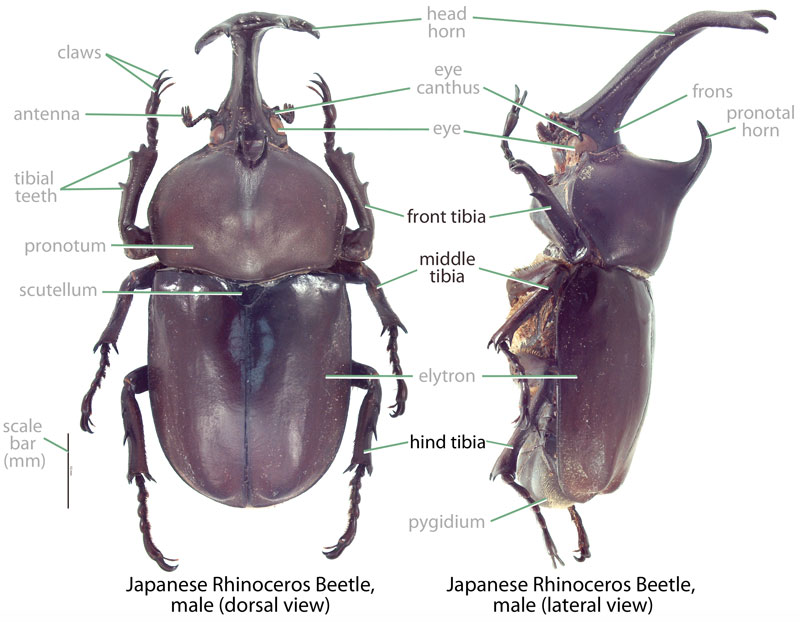 with 3 teeth on external margin; male teeth pointed; female teeth comparatively rounded; teeth may be worn in older specimens. Front tarsomeretarsomere:
with 3 teeth on external margin; male teeth pointed; female teeth comparatively rounded; teeth may be worn in older specimens. Front tarsomeretarsomere:
one of the sub-segments of the tarsus
with length of segments 2–4 (combined) more than 1.5 times that of segment 1 in male; front tarsomeretarsomere:
one of the sub-segments of the tarsus
with length of segments 2–4 (combined) less than 1.2 times that of segment 1 in female. Last sternitesternite:
the ventral part of a thoracic or abdominal segment
 of female with apexapex:
of female with apexapex:
point or edge furthest from the body
rounded posteriorly; apexapex:
point or edge furthest from the body
weakly quadratequadrate:
square-like in shape
in male.
(Habeck, 1962Habeck, 1962:
Habeck D. 1963. Description of immature stages of the Chinese rose beetle, Adoretus sinicus Burmeister (Coleoptera: Scarabaeidae). Proceedings of the Hawaiian Entomological Society 18: 251-258. full text (accessed 2015)): Grub C-shaped, not hump-backed, cylindrical, whitish. Maxillamaxilla:
set of paired mouthparts located posterior to the mandibles
with galeagalea:
outer branch or lobe of the maxilla
 and lacinialacinia:
and lacinialacinia:
inner portion of the maxilla fused. Lacinialacinia:
fused. Lacinialacinia:
inner portion of the maxilla of maxillamaxilla:
of maxillamaxilla:
set of paired mouthparts located posterior to the mandibles
with 3 well-developed terminal unciunci:
in scarab larvae, a hooked process on the distal margin of the maxilla
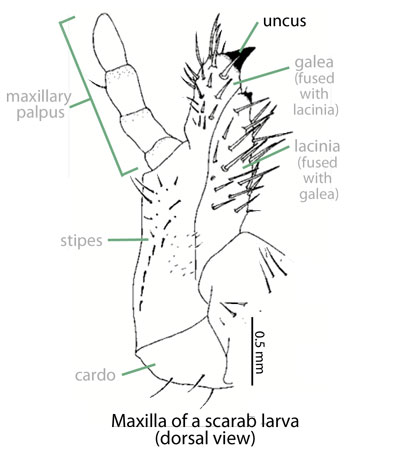 . Mandiblemandible:
. Mandiblemandible:
The crushing or chewing portion of an insects mouthparts
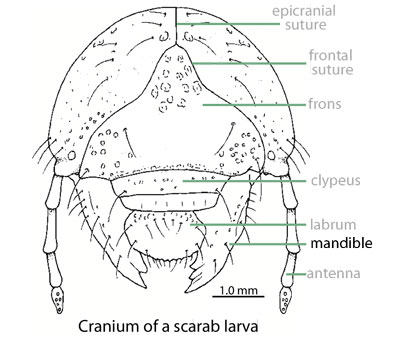 with a ventralventral:
with a ventralventral:
of or relating to the lower surface; opposite of dorsal
, elongate, oval, stridulatory area consisting of a numerous transversetransverse:
extending horizontally across a surface
, granular ridges; left mandiblemandible:
The crushing or chewing portion of an insects mouthparts
 with outer scissorial toothscissorial tooth:
with outer scissorial toothscissorial tooth:
tooth-like projection on the scissorial area of the mandible
 wider than inner toothtooth:
wider than inner toothtooth:
a pointed process from an appendage or margin, often in reference to the tibia
; right mandiblemandible:
The crushing or chewing portion of an insects mouthparts
 with teeth equal in width but outer toothtooth:
with teeth equal in width but outer toothtooth:
a pointed process from an appendage or margin, often in reference to the tibia
projects farther than inner. Maxillary stridulatory teeth with apical points anteriorly projecting. PlegmatiaPlegmatia:
in scarab larvae, a paired, lateral region with a somewhat sclerotized surface bordered by marginal spines with acanthoparia
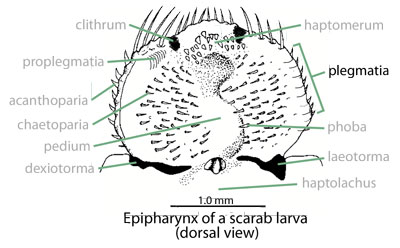 present. Haptomerumhaptomerum:
present. Haptomerumhaptomerum:
in larvae, the medio-anterior (middle of upper) portion of the epipharynx, composed of sensory spots
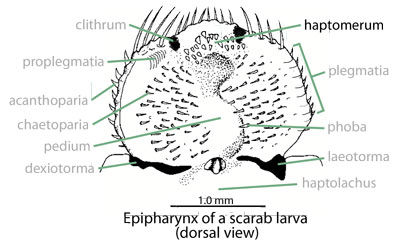 of epipharynxepipharynx:
of epipharynxepipharynx:
lobe on the interior surface of the labrum or clypeus
with a dense, transversetransverse:
extending horizontally across a surface
row of 5–8 (usually 6) heliheli:
in scarab larvae, a coarse spine on or near the haptomerum
. Last antennal segment with single dorsaldorsal:
of or relating to the upper surface; opposite of ventral
sensory spot. Respiratory plate C-shaped with numerous oval to round openings surrounding a prominent oval bullabulla:
in scarab larvae, the sclerite that closes the trachea
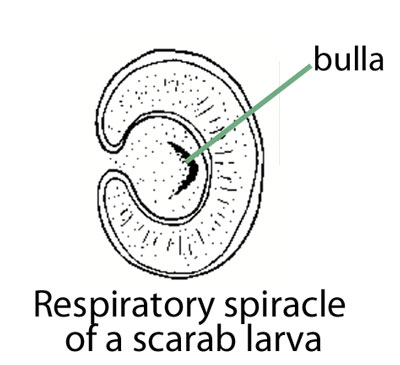 . Rasterraster:
. Rasterraster:
in scarab larvae, a complex of setose, spiny, and bare areas on the ventral surface of the last abdominal segment with a subtriangular tegesteges:
with a subtriangular tegesteges:
in larvae, groupings of setae
of hamatehamate:
hook-like in shape
setae; palidiapalidia:
paired group(s) of recumbent (reclining) spines, usually occurring in rows; part of the raster
absent. Anal opening slightly curved, transversetransverse:
extending horizontally across a surface
. Lower anal lip with 8 stout setaesetae:
small, hair-like structure
, 10 long slender setaesetae:
small, hair-like structure
and 10 short slender setaesetae:
small, hair-like structure
.
Japan and Taiwan. Although this species is native to Japan and Taiwan (Mau and Kessing, 1991Mau and Kessing, 1991:
Mau R and Kessing J. 1991. Adoretus sinicus . University of Hawaii Publishing, Honolulu, Hawaii, USA. Available from http://www.extento.hawaii.edu/kbase/crop/Type/adoretus.htm (accessed 2015).), it has spread widely and is now established in a great number of locations including Cambodia, the Caroline Islands, China, Guam, Hawaii, Indonesia, Singapore, Thailand, and Vietnam (McQuate and Jameson, 2011McQuate and Jameson, 2011:
McQuate G and Jameson M. 2011. Sex determination in the Chinese rose beetle, Adoretus sinicus , and overview of Adoretus species of biosecurity concern. Journal of Insect Science 64: 1-18. full text (accessed 2015)).
This species has been recorded feeding on over 500 species of plants (Hession et al., 1994Hession et al., 1994:
Hession R, Arita L, Furutani S, Fukada M. 1994. Field observations on the mating behavior of the Chinese rose beetle, Adoretus sinicus Burmeister (Coleoptera: Scarabaeidae), in Hawaii. Journal of Hawaiian and Pacific Agriculture 5: 37-42.), including such economically important species as broccoli (Brassica oleracea), cabbage (Brassica oleracea), cacao (Theobroma cacao), Chinese broccoli (Brassica oleracea), Chinese cabbage (Brassica rapa), chiso (Perilla frutescens), corn (Zea mays), cotton (Gossypium barbadense), cucumber (Cucumis sativus), eggplant (Solanum melongena), ginger (Zingiber officinale), grape (Vitis labrusca), green beans (Phaseolus vulgaris), jack fruit (Artocarpus heterophyllus), okra (Hibiscus esculentus), peanuts (Arachis hypogaea), Oriental persimmon (Diospyros kaki), raspberry (Rubus niveus), roses (Rosa spp.), salak palm (Salacca zalacca), soybean (Glycine max), star fruit (Averrhoa carambola), strawberry (Fragaria chiloensis), sweet potato (Ipomoea batatas), taro (Colocasia esculenta), and tea (Camellia sinensis) (McQuate and Jameson, 2011McQuate and Jameson, 2011:
McQuate G and Jameson M. 2011. Sex determination in the Chinese rose beetle, Adoretus sinicus , and overview of Adoretus species of biosecurity concern. Journal of Insect Science 64: 1-18. full text (accessed 2015)). In Hawaii, this species is also known to damage several endangered native plants including kauila (Colubrina oppositifolia), hau kuahiwi (Hibiscadelphus distans), and ko’oloa’ula (Abutilon menziesii) (Howarth, 1985Howarth, 1985:
Howarth F. 1985. Impacts of alien land arthropods and mollusks on native plants and animals in Hawaii [pp. 149-179]. In: Hawaii's Terrestrial Ecosystems: Preservation and Management. University of Hawaii Publishing, Honolulu, Hawaii, USA. full text (accessed 2015)).
Adults are active year-round and emerge after dusk to feed, with large numbers often congregating on the same plant (McQuate and Jameson, 2011McQuate and Jameson, 2011:
McQuate G and Jameson M. 2011. Sex determination in the Chinese rose beetle, Adoretus sinicus , and overview of Adoretus species of biosecurity concern. Journal of Insect Science 64: 1-18. full text (accessed 2015)). During the day, adults hide in soil at the base of their food plant (Williams, 1931Williams, 1931:
Williams X. 1931. Handbook of the Insects and Other Invertebrates of Hawaiian Sugarcane Fields. Honolulu, Hawaii: Hawaiian Sugar Planters' Association. Advertiser Publisher Co.). Host plants can easily be identified by the distinctive lace-like damage inflicted upon the leaves (Arrow, 1917Arrow, 1917:
Arrow G. 1917. The fauna of British India including Ceylon and Burma. Coleoptera Lamellicornia Part II. (Rutelinae, Desmonychinae, and Euchirinae). Taylor and Francis.). Developmental time was examined by Habeck (1964) in laboratory-reared specimens. He found that females deposited eggs 4 cm (1.6 in) in soil, with larvaelarvae:
the immature form of an insect; in scarabs, also called grub or white grub; preceded by the egg stage, followed by the pupal stage
 emerging after 7–16 days. Warmer temperatures resulted in shorter emergence times. The first instarinstar:
emerging after 7–16 days. Warmer temperatures resulted in shorter emergence times. The first instarinstar:
in scarabs, one of the three larval growth phases (i.e., first instar, second instar, third instar), each ending with the larvae molting to the next phase
lasted 19.6–22.8 days, the second lasted 14.5–16.8 days, and the final lasted 34.3–44.4 days. The pupal stage lasts 11–17 days. Interestingly, larvaelarvae:
the immature form of an insect; in scarabs, also called grub or white grub; preceded by the egg stage, followed by the pupal stage
 appear to develop more rapidly in the field, with the egg to adult cycle lasting 6–7 weeks (Mau and Kessing, 1991Mau and Kessing, 1991:
appear to develop more rapidly in the field, with the egg to adult cycle lasting 6–7 weeks (Mau and Kessing, 1991Mau and Kessing, 1991:
Mau R and Kessing J. 1991. Adoretus sinicus . University of Hawaii Publishing, Honolulu, Hawaii, USA. Available from http://www.extento.hawaii.edu/kbase/crop/Type/adoretus.htm (accessed 2015).). LarvaeLarvae:
the immature form of an insect; in scarabs, also called grub or white grub; preceded by the egg stage, followed by the pupal stage
 are detritivores and do not appear to feed on living plant tissues (Mau and Kessing, 1991Mau and Kessing, 1991:
are detritivores and do not appear to feed on living plant tissues (Mau and Kessing, 1991Mau and Kessing, 1991:
Mau R and Kessing J. 1991. Adoretus sinicus . University of Hawaii Publishing, Honolulu, Hawaii, USA. Available from http://www.extento.hawaii.edu/kbase/crop/Type/adoretus.htm (accessed 2015).).
Severe. This species is a known biosecurity threat with a long history of biological invasion. It has spread continuously over the past 120 years with recent records coming from specimens intercepted in India (Bhawane et al., 2012Bhawane et al., 2012:
Bhawane G, Mamlayya A, Wagh S, Chaugule A. 2012. Diversity of white grub beetles and their host range from northern Western Ghats, Kolhapur District (MS) India. The Bioscan 7: 589-596.) and Australia (Stanway et al., 2001). It is officially recognized by the USDA as a class B pest (USDA APHIS, 2012USDA APHIS, 2012:
Anonymous. 2012. 2012 Prioritized Offshore Pest List. USDA APHIS. full text (accessed 2015)), and it is officially regarded as a pest with high risk of introduction in California (Cosner, 2013Cosner, 2013:
Cosner C. 2013. Invasive species pathway risk analysis for California. PhD dissertation, University of California, Davis, California. full text (accessed 2015)). It damages a great range of economically important plants, causing severe and economically significant damage (McQuate and Jameson, 2011McQuate and Jameson, 2011:
McQuate G and Jameson M. 2011. Sex determination in the Chinese rose beetle, Adoretus sinicus , and overview of Adoretus species of biosecurity concern. Journal of Insect Science 64: 1-18. full text (accessed 2015)).
Established. This species is found on all the major islands of Hawaii (Nishida, 2002Nishida, 2002:
Nishida G (editor). 2002. Hawaiian terrestrial arthropod checklist, fourth edition. Bishop Museum Technical Report 22: 1-313.). It became established in the late 19th century, with the earliest record dating to 1891 (Riley and Howard, 1893Riley and Howard, 1893:
Riley C and Howard L. 1893. An injurious Hawaiian beetle. Insect Life 6: 43.). By 1893, it was “rapidly becoming a most serious pest” (Riley and Howard, 1893Riley and Howard, 1893:
Riley C and Howard L. 1893. An injurious Hawaiian beetle. Insect Life 6: 43.). Across its range, Adoretus sinicus may be found in many habitats including urban, agricultural, and wilderness areas (García-Moll, 2013).
Established. This species has long been established in Guam, with the first report dating to 1949 (Pemberton, 1954Pemberton, 1954:
Pemberton C. 1954. Report for 1949-1954, invertebrates consultant committee for the Pacific. The Pacific Science Board, National Academy of Sciences, National Research Council, Washington, D.C., USA.).
It is thought that Adoretus sinicus first arrived to Hawaii as larvaelarvae:
the immature form of an insect; in scarabs, also called grub or white grub; preceded by the egg stage, followed by the pupal stage
 or eggs transported in soil associated with plants imported from Asia (Ohaus, 1935Ohaus, 1935:
or eggs transported in soil associated with plants imported from Asia (Ohaus, 1935Ohaus, 1935:
Ohaus F. 1935. Checklist of the Rutelinae (Coleoptera, Scarabaeidae) of Oceania. Bernice P. Bishop Museum Occasional Papers 11: 3-9.; Pemberton, 1964Pemberton, 1964:
Pemberton C. 1964. Highlights in the history of entomology in Hawaii 1778-1963. Pacific Insects 6: 689-729. full text (accessed 2015)). Adults are attracted to dim lights at night (though oddly may be deterred by bright lights), and it is possible that they would be attracted to artificialy lit docks or airports and hitchhike aboard freight and cargo. Indeed, this species has been intercepted in Australia on maritime containers (Stanway et al., 2001). This beetle is very common in Hawaii (pers. observation), and it should be regarded as having a very high likelihood of spreading to the southern U.S. and U.S. territories, including Puerto Rico and the U.S. Virgin Islands.
This species is extremely similar to the closely related Adoretus compressus. The two species cannot reliably be separated based on external morphology. Identification requires dissection and examination of the male genitalia.
Adoroleptus sinicus (Burmeister)
Prevent the spread of this USDA regulated pest by reporting your observation at our iNaturalist project.